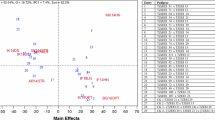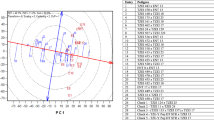Abstract
Estimates of combining abilities and heterosis of inbred lines are imperative for selection of suitable parents of maize hybrids. This study examined the combining ability of 24 drought-tolerant maize inbred lines, 12 each from International Centre for Maize and Wheat Improvement (CIMMYT) and International Institute of Tropical Agriculture (IITA). The lines were allotted into six groups each comprising four lines. The four lines in one group were used as females and crossed to the four lines in another group as males in six different sets using a North Carolina Design II mating scheme to generate 96 hybrids. The hybrids were evaluated together with four checks across six environments in the rainforest and savannah agro-ecologies of Nigeria between 2011 and 2012. The parental inbred lines were also evaluated in separate trial in each location. Significant hybrids × environment interaction was observed for grain yield and other measured traits. GCA effects accounted for 83.3% of the variation for grain yield at Bagauda, 78.1% at Saminaka, and 77.7% at Ikenne. GCA also contributed 91.1 and 80.0% to the variation observed for plant height and ear aspect, respectively, across the environments. Significant SCA × environment interaction detected for grain yield suggests that hybrids were not stable across test environments. Prediction of grain yield in hybrids using midparent values resulted in a R 2 value of 0.13. Midparent heterosis for grain yield varied from 80 to 411%, with the top 36 hybrids recording >200%. Four CIMMYT (EXL02, EXL06, EXL04 and EXL16) and three IITA (ADL33, ADL41, and ADL32) inbred lines had positive and significant GCA effects for grain yield across environments. The novel alleles present in the CIMMYT lines will improve the adapted IITA germplasm in a new population for extracting new set of more productive inbred lines for develo** adapted high yielding drought-tolerant maize hybrids.

Similar content being viewed by others
References
Abalu GI (2001) Policy issues in maize research and development in sub-Saharan Africa in the next millennium. In: Badu-Apraku B, Fakorede MAB, Ouedraogo M, Carsky RJ (eds) Impact, challenges and prospects of maize research and development in west and Central Africa. Proceedings of a regional maize workshop, 4–7 May 1999. WECAMAN/IITA-Cotonou, Benib Republic
Abdulai MS, Sallah PYK, Safo-Kantanka O (2007) Maize grain yield stability analysis in full season lowland maize in Ghana. J Agric Biol 9(1):41–45
Abera W, Hussein S, Derera J, Laing M (2015) Heterosis and combining ability of elite maize inbred lines under northern corn leaf blight disease prone environments of the mid-altitude tropics. Euphytica. doi:10.1007/s10681-015-1619-5
Adebayo MA, Menkir A, Blay E, Gracen V, Danquah E (2014) Genetic analysis of drought tolerance in adapted × exotic crosses of maize inbred lines under managed stress conditions. Euphytica 196:261–270. doi:10.1007/s10681-013-1029-5
Adebayo MA, Menkir A, Malaku G, Blay E, Gracen V, Danquah E, Ladejobi O (2015) Diversity assessment of drought-tolerant exotic and adapted maize inbred lines with microsatellite markers. J Crop Sci Biotechnol 18(3):147–154
Araus JL, Sanchez C, Cabrera-Bosquet L (2010) Is heterosis in maize mediated through better water use? New Phytol 187:392–406
Badu-Apraku B, Menkir A, Ajala SO, Akinwale RO, Oyekunle M, Obeng-Antwi K (2010) Performance of tropical early-maturing maize cultivars in multiple stress environments. Can J Plant Sci 90:831–852
Badu-Apraku B, Akinwale RO, Ajala SO, Menkir A, Fakorede MAB, Oyekunle M (2011) Relationships among traits of tropical early maize cultivars in contrasting environments. Agron J 103(3):717–729
Baker RJ (1988) Tests for crossover genotype–environmental interactions. Can J Plant Sci 68:405–410
Bello OB, Olaoye G (2009) Combining ability for maize grain yield and other agronomic characters in a typical southern guinea savanna ecology of Nigeria. Afr J Biotechnol 8(11):2518–2522
Cochran WG, Cox GM (1960) Experimental designs. Wiley, New York
Derera J, Tongoona P, Vivek BS, Laing MD (2008) Gene action controlling grain yield and secondary traits in southern African maize hybrids under drought and non-drought environments. Euphytica 162(3):411–422
Dhliwayo T, Pixley K, Menkir A, Warburton M (2009) Combining ability, genetic distances, and heterosis among elite CIMMYT and IITA tropical maize inbred lines. Crop Sci 49:1201–1210
East EM (1936) Heterosis. Genetics 21:375–397
East EM, Hayes HK (1912) Heterozygosis in evolution and in plant breeding. USDA Bur Plant Ind Bull 243:7–58
Falconer DS, Mackay TFC (1996) Introduction to quantitative genetics, 4th edn. Longman, Essex
Giauffret C, Lothrop J, Dorvillez D, Gouesnard B, Derieux M (2000) Genotype × environment interactions in maize hybrids from temperate or highland tropical origin. Crop Sci 40:1004–1012
Hallauer AR, Miranda JB (1988) Quantitative genetics in maize breeding, 2nd edn. Iowa State University Press, Ames
Han GC, Vasal SK, Beck DL, Elias E (1991) Combining ability of inbred lines derived from CIMMYT maize (Zea mays L.) germplasm. Maydica 36:57–64
Johnson IJ, Hayes HK (1940) The value in hybrid combinations of inbred lines of corn selected from single crosses by the pedigree method of breeding. J Am Soc Agron 32:479–485
Kang MS (1994) Applied quantitative genetics. Kang, M.S. Publisher, Baton Rouge
Kim SK (1997) Achievements, challenges and future direction of hybrid maize research and production in West and Central Africa. In: Badu-Apraku B, Akoroda MO, Quedraogo M, Quin FM (eds) Proceeding of a regional maize workshop, June 1995. IITA, Cotonou, Benin Republic, pp 42–82
Kim SK, Ajala SO (1996) Combining ability of tropical maize germplasm in West Africa II. Tropical Vs Temperate × Tropical origins. Maydica 41:135–141
Kim SK, Efron Y, Khadr F, Fajemisin JM, Lee M (1987) Registration of 16 maize-streak virus resistant tropical maize parental inbred lines. Crop Sci 2:824–825
Kim SK, Ajala SO, Brewbaker JL (1999) Combining ability of tropical maize germplasm in West Africa III. Tropical maize inbreds. Maydica 44:285–291
Menkir A, Ayodele M (2005) Genetic analysis of resistance of gray leaf spot of midaltitude maize inbred lines. Crop Sci 45:163–170
Menkir A, Melake-Berhan A, The C, Ingelbrecht I, Adepoju A (2004) Grou** of tropical mid-altitude maize inbred lines on the basis of yield data and molecular markers. Theor Appl Genet 108:1582–1590
Moll RH, Salhuana WS, Robinson HF (1962) Heterosis and genetic diversity in variety crosses of maize. Crop Sci 2(3):197–198
Nass LL, Lima M, Vencovsky R, Gallo PB (2000) Combining ability of maize inbred lines evaluated in three environments in Brazil. Sci Agric 57(1):129–134
Nelson PT, Goodman MM (2008) Evaluation of elite CIMMYT maize inbreds for use in temperate breeding. Crop Sci 45(1):85–92
SAS (2009) Statistical Analysis System Proprietary Software Release 9.2. SAS Institute, Inc., Cary, NC
Singh RK, Chaudhary BD (1985) Biometrical methods in quantitative genetic analysis. Kalyyani Publishers, Ludhiana
Sprague GF, Tatum LA (1942) General vs. specific combining ability in single crosses of corn. J Am Soc Agron 34:923–932
Tollenaar M, Lee EA (2006) Dissection of physiological processes underlying grain yield in maize by examining genetic improvement and heterosis. Maydica 51:399–408
Tollenaar MA, Ahmadzadeh A, Lee E (2004) Physiological basis of heterosis for grain yield in maize. Crop Sci 44:2086–2094
Tracy WF, Chandler MA (2004) The historical and biological basis of the concept of heterotic groups in Corn Belt Dent Maize. In: Plant breeding: The Arnel R. Hallauer international symposium, pp 219–233. Iowa State University Press, Ames. doi:10.1002/9780470752708.ch16
Acknowledgements
This report is a part of Ph.D. thesis research fully funded by the Alliance for a Green Revolution in Africa (AGRA) at West Africa Centre for Crop Improvement (WACCI), University of Ghana, Legon, and the International Institute of Tropical Agriculture. The lead author is immensely grateful for the funding. All the staff members of Maize Improvement Unit at the International Institute of Tropical Agriculture (IITA), Ibadan, Nigeria, are appreciated for providing technical supports during the field experiments.
Author information
Authors and Affiliations
Corresponding author
Rights and permissions
About this article
Cite this article
Adebayo, M.A., Menkir, A., Blay, E. et al. Combining ability and heterosis of elite drought-tolerant maize inbred lines evaluated in diverse environments of lowland tropics. Euphytica 213, 43 (2017). https://doi.org/10.1007/s10681-017-1840-5
Received:
Accepted:
Published:
DOI: https://doi.org/10.1007/s10681-017-1840-5




